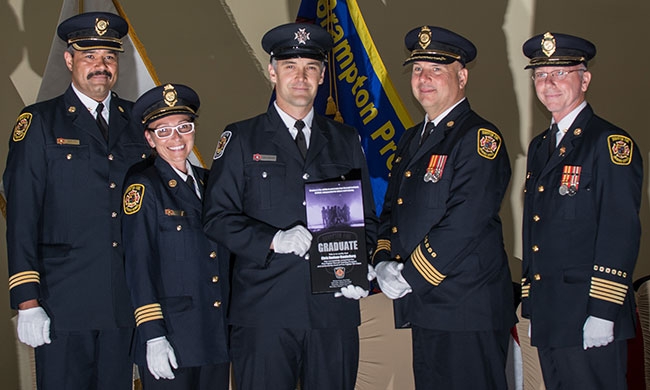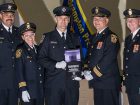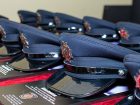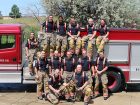
Features
Training
Back in service: A training officer returns to the trucks to learn from recruits
In my thirteenth year in the fire service, I left my role as a training officer and returned to the fire ground as a first-class firefighter. I am now back in service and responding to calls.
August 24, 2017
By Christopher Vanderburg
 Training officer Chris Vanderburg (centre) went back to class – recruit class – and found that fellow students had great insight and ideas. Former Brampton
Training officer Chris Vanderburg (centre) went back to class – recruit class – and found that fellow students had great insight and ideas. Former BramptonSome may perceive this move as a step backward, but trading the desk job for the familiarity of the station feels good. I recently graduated from my 16-week recruit class; not a class that I was teaching, but my recruit class. After years as a training officer, I was the student.
In 2004, I joined the Big White Fire Department in British Columbia as a volunteer. Before I could blink, I became a senior firefighter and, shortly thereafter, I was given a red lieutenant’s helmet. By 2008, I had transitioned to a paid member of our composite department, and began my full-time career as a suppression captain and fire-prevention officer, later progressing to assistant training officer. I know I surprised my chief and mentor Jamie Svendsen when I withdrew my application for the deputy chief’s position for which he had encouraged me to apply. With fewer than 10 years of fire-service experience, I didn’t feel ready. That was the first time I took a step backward. It was a good decision at the time. Soon afterward, I returned to my home province of Ontario to join the training division at Brampton Fire & Emergency Services.
“When are you writing to become a captain?” “Do you think you’ll want to be a chief one day?” “Have you thought about instructing or training?” These questions are typically heard in fire halls, and are founded in an obsession with moving up the corporate ladder. Those who become good firefighters are often encouraged to move into officer positions. We are hardwired as a society to keep pushing for the next level, to get more stripes, higher pay, more responsibility. It feels strange returning to square one instead of pushing upwards. I believe that there is value in simply appreciating that it takes a full career just to become a good firefighter, and that solid senior firefighters form the core of the industry. That being said, it takes a team to run a fire department.
My decision to go back to the trucks was based on personal circumstances. It was hard to leave my training-division colleagues; I felt as if I was leaving them in the lurch. I will be forever grateful for the compassion, understanding and support of those closest to me both on and off the job.
I tried to slip into the recruit class quietly. I ditched the uniform and wore business-casual clothes for the pre-class meeting with human resources. I was hoping to fly under the radar for a couple of weeks but it took about an hour before I was recognized by a fellow recruit. By lunch on that first day, the other 12 recruits learned that there was a previous training officer among them. In the first few weeks, I sensed the uncertainty of my classmates; they even joked about me being an undercover boss. I am grateful for their acceptance and inclusion.
Going through a recruit program was humbling; in many ways, I felt as if I did indeed gain the insight of an undercover boss. Here are a few thoughts about my experience.
- Being immersed with recruits is invigorating; it re-energized my passion for the job. I always felt pumped up as a training officer whenever a class of recruits started, but this feeling was amplified as a participant. The experience also made me recognize how much stress I was under as a training officer and how enjoyable it was to sit at the back of the class instead of standing up front and being responsible for content, logistics and group performance. Expectations for training officers come from every level of the organization and are often idealistic; it was nice to be able to focus solely on my own skills and abilities again.
- In Brampton, our training division had made exceptional strides in creating the right training environment; you can build an environment that allows members to reach their potential, or you can shut them out and not listen to them. Building a culture of acceptance and learning should rank high on any chief’s priority list. This begins in recruit class and it was evident through the growth of some of my classmates over the 16-week program that our department is on the right path using this philosophy.
- Our class drilled hard before the official start time of the day and even during lunches, downtime and breaks. Generally, recruits try hard to prove themselves; they don’t shy away from hard work. Empower them: allow them access to the equipment during down time to practice and drill; let them experiment with techniques and let them ask questions. They <i>will</i> rise to the occasion and surprise you if you create the right learning environment. This may not be possible in all departments, but having instructors available to supervise and allowing extra practice time makes a big difference in individual performance.
- Even the most confident of my classmates hesitated to ask questions to the most approachable instructors, worrying that doing so would make them appear vulnerable. Instructors must work extra hard to break down those barriers. Everyone benefits when communication lines are open.
- I learned that I had room to improve on basic skills that I believed I had mastered People need to be given time to run drills and practice the basics. There is so much content to cover; I counted 411 separate skills during recruit training. There is a big difference between demonstrating something and letting recruits try it just once before signing off, and drilling until the skills are committed to muscle memory. Ensure that your recruit program is developing skilled firefighters and not simply in place to check off boxes.
- The best instructors created a subject-centered classroom and welcomed input and experience from the students. Be careful not to forcefully insert your methods into your recruits’ training. We need to develop firefighters’ critical thinking, and I learned just as much from some of my classmates as I did from some of the instructors and my previous mentors.
For the record, I was afforded no favours as a recruit. I had to submit a resume, pass the Ontario Fire Administration Inc. fitness test, go through the interview process, and pick up a crateful of textbooks before I began the recruit-training program. I used the side entrance to the building like the other recruits, and parked at the very back of the lot. Two hours before we started our training days, I would occasionally beat another recruit known as Rusty at getting the coffee ready for the training staff. No slack given, but also, none wanted.
Thirteen years in, I got the full recruit experience, or as close as it could be given the circumstances. Both me, and my fire department, will benefit. This fantastic opportunity allowed me to focus on mastering task level skills again and I am grateful to have been able to get back to the basics.
Print this page
Advertisement
- Firelines: Embracing a new generation of firefighters
- Comms Centre: Buy-in is critical for training standard


